Analysis of Green Energy Implementation in Sub-Saharan Africa
VerifiedAdded on 2020/04/21
|7
|1341
|62
Report
AI Summary
This report examines the potential for implementing green energy techniques in Sub-Saharan Africa, focusing on renewable sources like solar, wind, geothermal, and biomass. It highlights the abundant renewable energy resources in the region and the opportunities for investment, particularly from the United Kingdom, in developing smart electricity grids and sustainable energy solutions. The report discusses the challenges of transitioning from non-renewable sources and emphasizes the need for partnerships and investments to achieve carbon reduction goals and economic development. It explores the potential for high voltage direct current (HVDC) transmission to reduce energy losses and the role of the UK in providing expertise and technology. The report recommends scaling up investment using smart grid systems to capitalize on renewable energy sources, which is a step towards a cleaner, more sustainable energy future. The conclusion emphasizes that Sub-Saharan Africa can take advantage of renewable energy sources, including wind, solar, geothermal, and biomass, which requires significant investments and efforts by the partners involved.
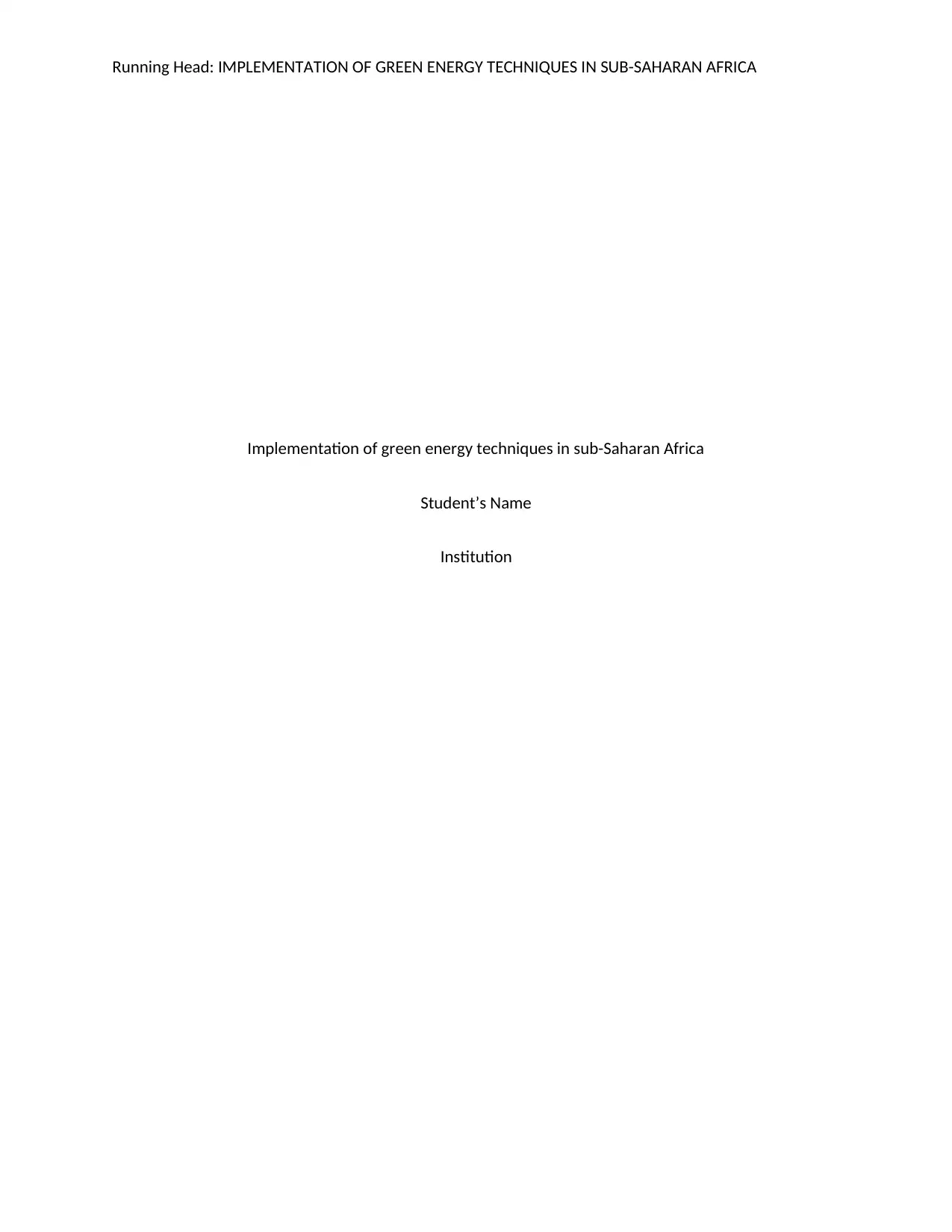
Running Head: IMPLEMENTATION OF GREEN ENERGY TECHNIQUES IN SUB-SAHARAN AFRICA
Implementation of green energy techniques in sub-Saharan Africa
Student’s Name
Institution
Implementation of green energy techniques in sub-Saharan Africa
Student’s Name
Institution
Paraphrase This Document
Need a fresh take? Get an instant paraphrase of this document with our AI Paraphraser
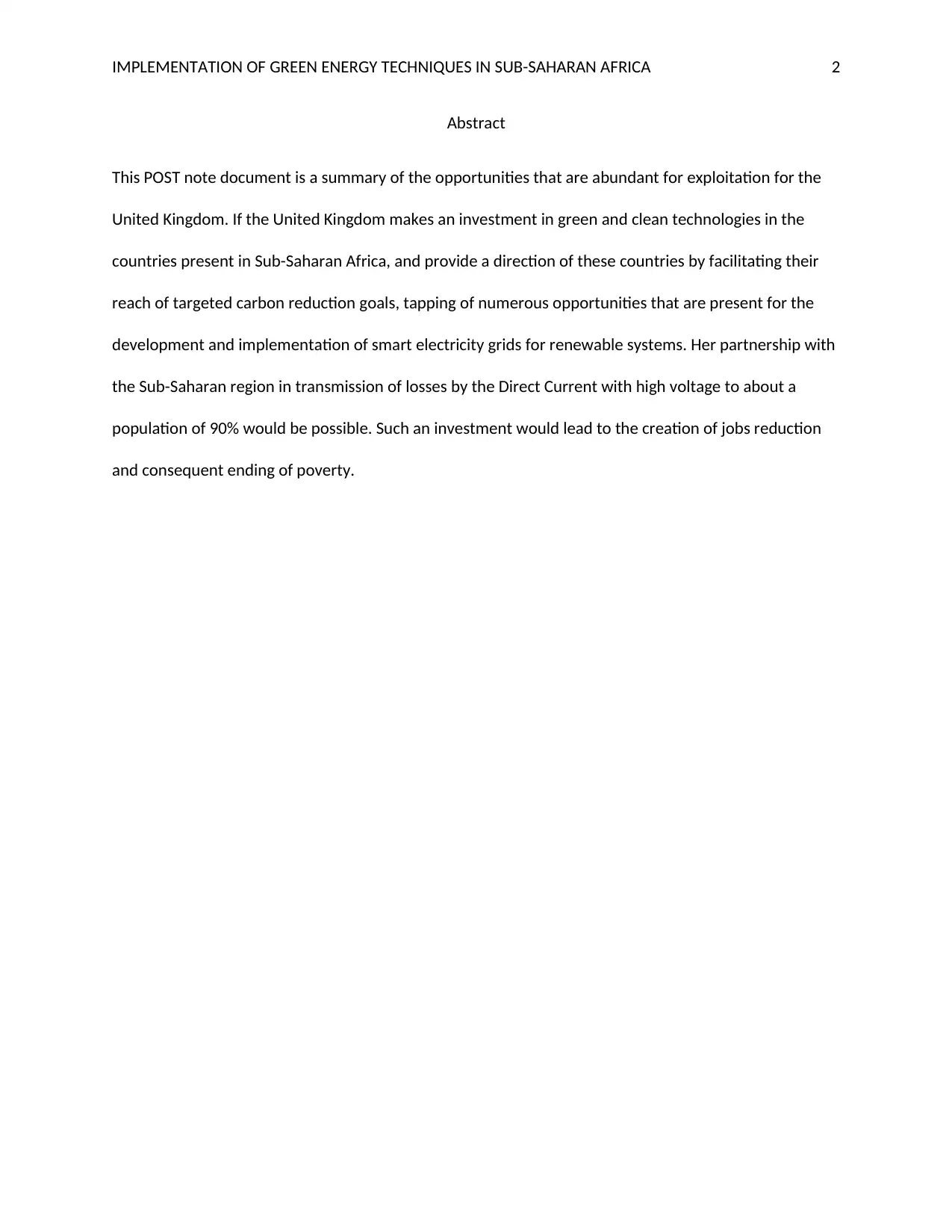
IMPLEMENTATION OF GREEN ENERGY TECHNIQUES IN SUB-SAHARAN AFRICA 2
Abstract
This POST note document is a summary of the opportunities that are abundant for exploitation for the
United Kingdom. If the United Kingdom makes an investment in green and clean technologies in the
countries present in Sub-Saharan Africa, and provide a direction of these countries by facilitating their
reach of targeted carbon reduction goals, tapping of numerous opportunities that are present for the
development and implementation of smart electricity grids for renewable systems. Her partnership with
the Sub-Saharan region in transmission of losses by the Direct Current with high voltage to about a
population of 90% would be possible. Such an investment would lead to the creation of jobs reduction
and consequent ending of poverty.
Abstract
This POST note document is a summary of the opportunities that are abundant for exploitation for the
United Kingdom. If the United Kingdom makes an investment in green and clean technologies in the
countries present in Sub-Saharan Africa, and provide a direction of these countries by facilitating their
reach of targeted carbon reduction goals, tapping of numerous opportunities that are present for the
development and implementation of smart electricity grids for renewable systems. Her partnership with
the Sub-Saharan region in transmission of losses by the Direct Current with high voltage to about a
population of 90% would be possible. Such an investment would lead to the creation of jobs reduction
and consequent ending of poverty.
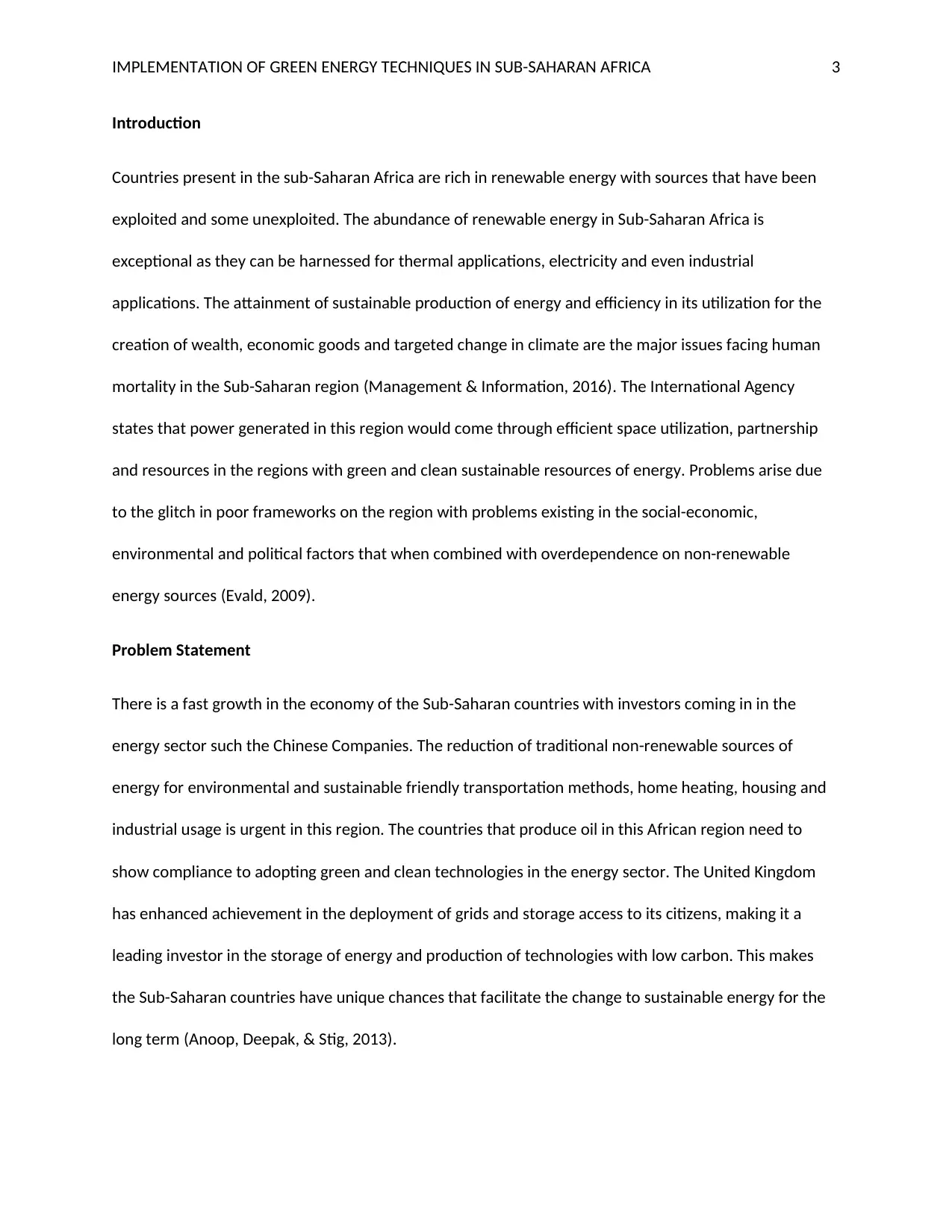
IMPLEMENTATION OF GREEN ENERGY TECHNIQUES IN SUB-SAHARAN AFRICA 3
Introduction
Countries present in the sub-Saharan Africa are rich in renewable energy with sources that have been
exploited and some unexploited. The abundance of renewable energy in Sub-Saharan Africa is
exceptional as they can be harnessed for thermal applications, electricity and even industrial
applications. The attainment of sustainable production of energy and efficiency in its utilization for the
creation of wealth, economic goods and targeted change in climate are the major issues facing human
mortality in the Sub-Saharan region (Management & Information, 2016). The International Agency
states that power generated in this region would come through efficient space utilization, partnership
and resources in the regions with green and clean sustainable resources of energy. Problems arise due
to the glitch in poor frameworks on the region with problems existing in the social-economic,
environmental and political factors that when combined with overdependence on non-renewable
energy sources (Evald, 2009).
Problem Statement
There is a fast growth in the economy of the Sub-Saharan countries with investors coming in in the
energy sector such the Chinese Companies. The reduction of traditional non-renewable sources of
energy for environmental and sustainable friendly transportation methods, home heating, housing and
industrial usage is urgent in this region. The countries that produce oil in this African region need to
show compliance to adopting green and clean technologies in the energy sector. The United Kingdom
has enhanced achievement in the deployment of grids and storage access to its citizens, making it a
leading investor in the storage of energy and production of technologies with low carbon. This makes
the Sub-Saharan countries have unique chances that facilitate the change to sustainable energy for the
long term (Anoop, Deepak, & Stig, 2013).
Introduction
Countries present in the sub-Saharan Africa are rich in renewable energy with sources that have been
exploited and some unexploited. The abundance of renewable energy in Sub-Saharan Africa is
exceptional as they can be harnessed for thermal applications, electricity and even industrial
applications. The attainment of sustainable production of energy and efficiency in its utilization for the
creation of wealth, economic goods and targeted change in climate are the major issues facing human
mortality in the Sub-Saharan region (Management & Information, 2016). The International Agency
states that power generated in this region would come through efficient space utilization, partnership
and resources in the regions with green and clean sustainable resources of energy. Problems arise due
to the glitch in poor frameworks on the region with problems existing in the social-economic,
environmental and political factors that when combined with overdependence on non-renewable
energy sources (Evald, 2009).
Problem Statement
There is a fast growth in the economy of the Sub-Saharan countries with investors coming in in the
energy sector such the Chinese Companies. The reduction of traditional non-renewable sources of
energy for environmental and sustainable friendly transportation methods, home heating, housing and
industrial usage is urgent in this region. The countries that produce oil in this African region need to
show compliance to adopting green and clean technologies in the energy sector. The United Kingdom
has enhanced achievement in the deployment of grids and storage access to its citizens, making it a
leading investor in the storage of energy and production of technologies with low carbon. This makes
the Sub-Saharan countries have unique chances that facilitate the change to sustainable energy for the
long term (Anoop, Deepak, & Stig, 2013).
⊘ This is a preview!⊘
Do you want full access?
Subscribe today to unlock all pages.

Trusted by 1+ million students worldwide
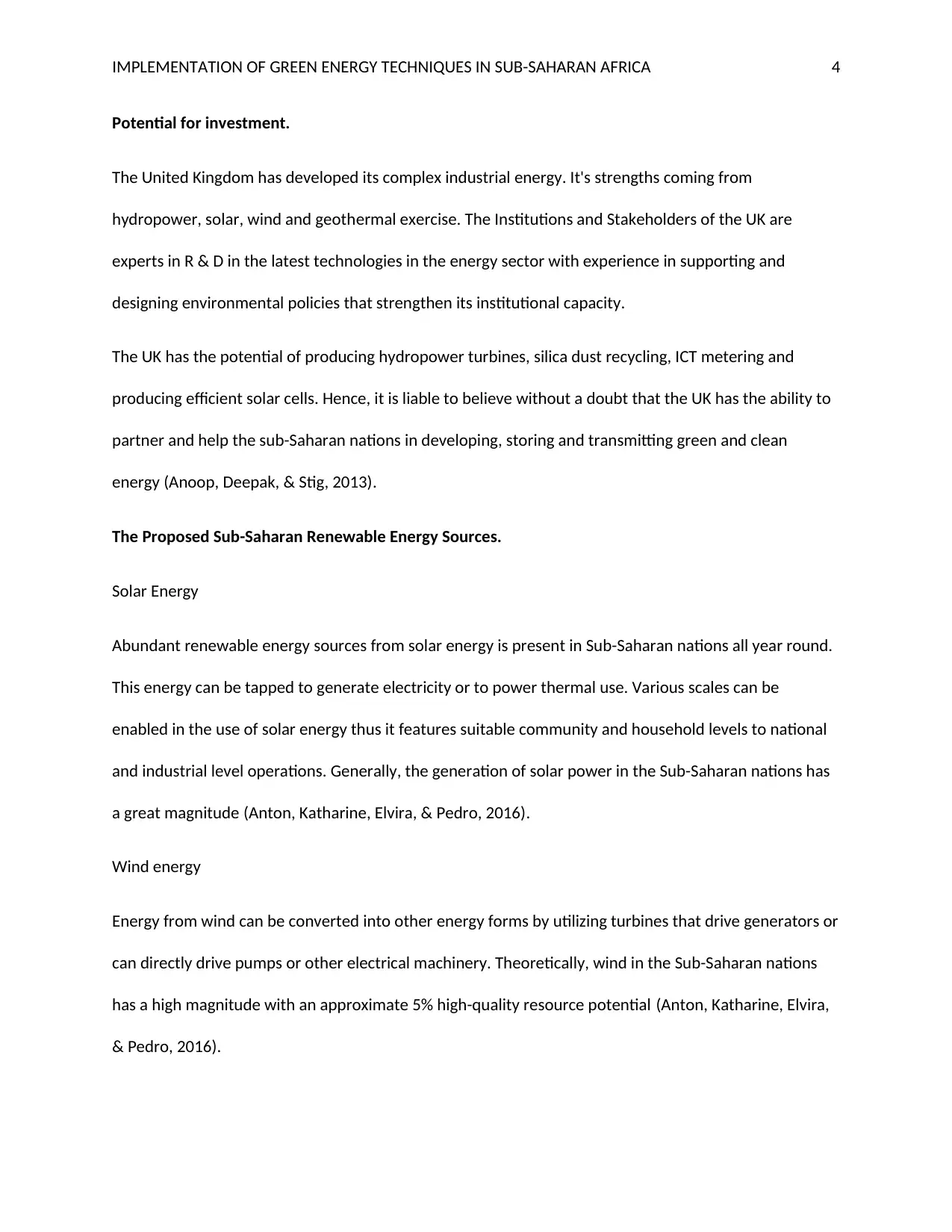
IMPLEMENTATION OF GREEN ENERGY TECHNIQUES IN SUB-SAHARAN AFRICA 4
Potential for investment.
The United Kingdom has developed its complex industrial energy. It's strengths coming from
hydropower, solar, wind and geothermal exercise. The Institutions and Stakeholders of the UK are
experts in R & D in the latest technologies in the energy sector with experience in supporting and
designing environmental policies that strengthen its institutional capacity.
The UK has the potential of producing hydropower turbines, silica dust recycling, ICT metering and
producing efficient solar cells. Hence, it is liable to believe without a doubt that the UK has the ability to
partner and help the sub-Saharan nations in developing, storing and transmitting green and clean
energy (Anoop, Deepak, & Stig, 2013).
The Proposed Sub-Saharan Renewable Energy Sources.
Solar Energy
Abundant renewable energy sources from solar energy is present in Sub-Saharan nations all year round.
This energy can be tapped to generate electricity or to power thermal use. Various scales can be
enabled in the use of solar energy thus it features suitable community and household levels to national
and industrial level operations. Generally, the generation of solar power in the Sub-Saharan nations has
a great magnitude (Anton, Katharine, Elvira, & Pedro, 2016).
Wind energy
Energy from wind can be converted into other energy forms by utilizing turbines that drive generators or
can directly drive pumps or other electrical machinery. Theoretically, wind in the Sub-Saharan nations
has a high magnitude with an approximate 5% high-quality resource potential (Anton, Katharine, Elvira,
& Pedro, 2016).
Potential for investment.
The United Kingdom has developed its complex industrial energy. It's strengths coming from
hydropower, solar, wind and geothermal exercise. The Institutions and Stakeholders of the UK are
experts in R & D in the latest technologies in the energy sector with experience in supporting and
designing environmental policies that strengthen its institutional capacity.
The UK has the potential of producing hydropower turbines, silica dust recycling, ICT metering and
producing efficient solar cells. Hence, it is liable to believe without a doubt that the UK has the ability to
partner and help the sub-Saharan nations in developing, storing and transmitting green and clean
energy (Anoop, Deepak, & Stig, 2013).
The Proposed Sub-Saharan Renewable Energy Sources.
Solar Energy
Abundant renewable energy sources from solar energy is present in Sub-Saharan nations all year round.
This energy can be tapped to generate electricity or to power thermal use. Various scales can be
enabled in the use of solar energy thus it features suitable community and household levels to national
and industrial level operations. Generally, the generation of solar power in the Sub-Saharan nations has
a great magnitude (Anton, Katharine, Elvira, & Pedro, 2016).
Wind energy
Energy from wind can be converted into other energy forms by utilizing turbines that drive generators or
can directly drive pumps or other electrical machinery. Theoretically, wind in the Sub-Saharan nations
has a high magnitude with an approximate 5% high-quality resource potential (Anton, Katharine, Elvira,
& Pedro, 2016).
Paraphrase This Document
Need a fresh take? Get an instant paraphrase of this document with our AI Paraphraser
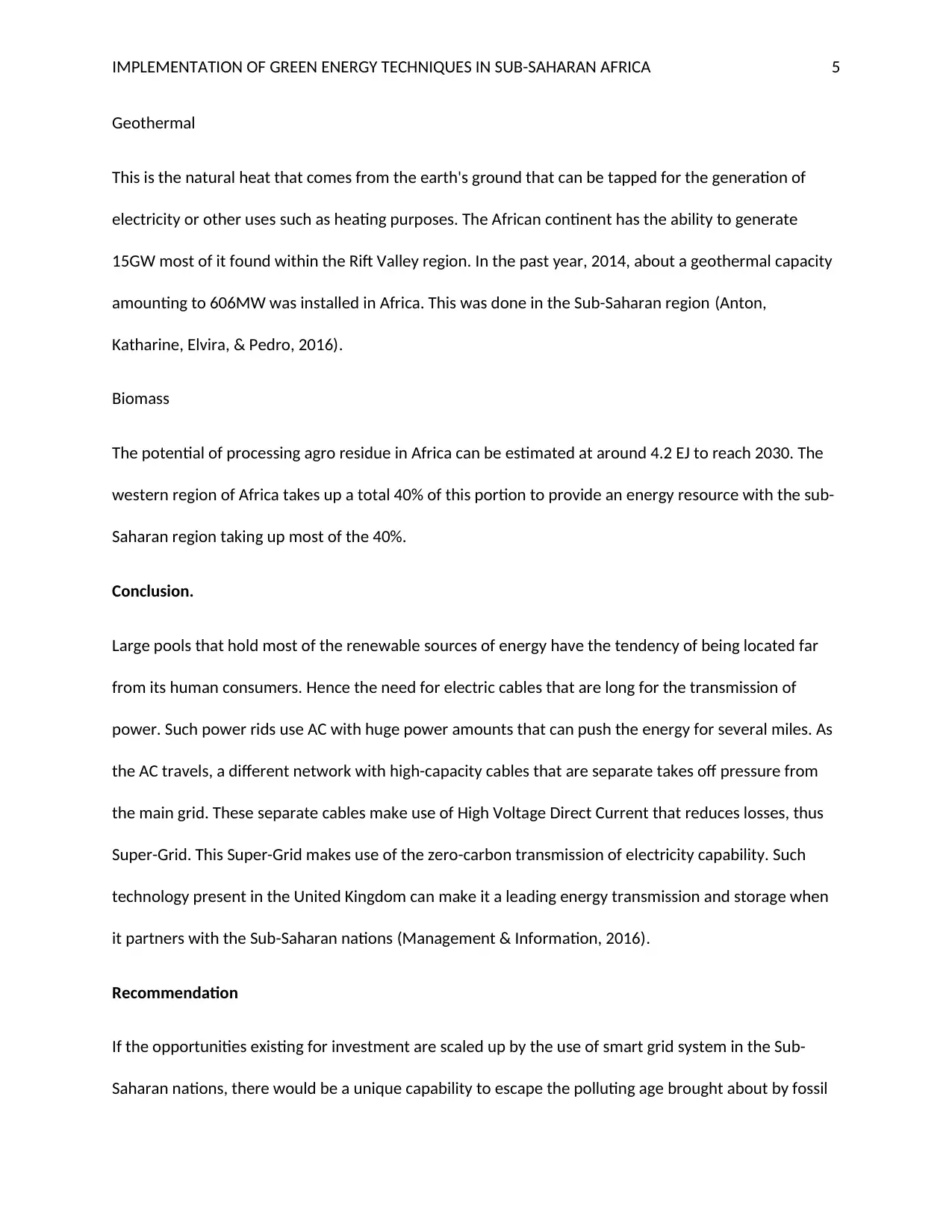
IMPLEMENTATION OF GREEN ENERGY TECHNIQUES IN SUB-SAHARAN AFRICA 5
Geothermal
This is the natural heat that comes from the earth's ground that can be tapped for the generation of
electricity or other uses such as heating purposes. The African continent has the ability to generate
15GW most of it found within the Rift Valley region. In the past year, 2014, about a geothermal capacity
amounting to 606MW was installed in Africa. This was done in the Sub-Saharan region (Anton,
Katharine, Elvira, & Pedro, 2016).
Biomass
The potential of processing agro residue in Africa can be estimated at around 4.2 EJ to reach 2030. The
western region of Africa takes up a total 40% of this portion to provide an energy resource with the sub-
Saharan region taking up most of the 40%.
Conclusion.
Large pools that hold most of the renewable sources of energy have the tendency of being located far
from its human consumers. Hence the need for electric cables that are long for the transmission of
power. Such power rids use AC with huge power amounts that can push the energy for several miles. As
the AC travels, a different network with high-capacity cables that are separate takes off pressure from
the main grid. These separate cables make use of High Voltage Direct Current that reduces losses, thus
Super-Grid. This Super-Grid makes use of the zero-carbon transmission of electricity capability. Such
technology present in the United Kingdom can make it a leading energy transmission and storage when
it partners with the Sub-Saharan nations (Management & Information, 2016).
Recommendation
If the opportunities existing for investment are scaled up by the use of smart grid system in the Sub-
Saharan nations, there would be a unique capability to escape the polluting age brought about by fossil
Geothermal
This is the natural heat that comes from the earth's ground that can be tapped for the generation of
electricity or other uses such as heating purposes. The African continent has the ability to generate
15GW most of it found within the Rift Valley region. In the past year, 2014, about a geothermal capacity
amounting to 606MW was installed in Africa. This was done in the Sub-Saharan region (Anton,
Katharine, Elvira, & Pedro, 2016).
Biomass
The potential of processing agro residue in Africa can be estimated at around 4.2 EJ to reach 2030. The
western region of Africa takes up a total 40% of this portion to provide an energy resource with the sub-
Saharan region taking up most of the 40%.
Conclusion.
Large pools that hold most of the renewable sources of energy have the tendency of being located far
from its human consumers. Hence the need for electric cables that are long for the transmission of
power. Such power rids use AC with huge power amounts that can push the energy for several miles. As
the AC travels, a different network with high-capacity cables that are separate takes off pressure from
the main grid. These separate cables make use of High Voltage Direct Current that reduces losses, thus
Super-Grid. This Super-Grid makes use of the zero-carbon transmission of electricity capability. Such
technology present in the United Kingdom can make it a leading energy transmission and storage when
it partners with the Sub-Saharan nations (Management & Information, 2016).
Recommendation
If the opportunities existing for investment are scaled up by the use of smart grid system in the Sub-
Saharan nations, there would be a unique capability to escape the polluting age brought about by fossil
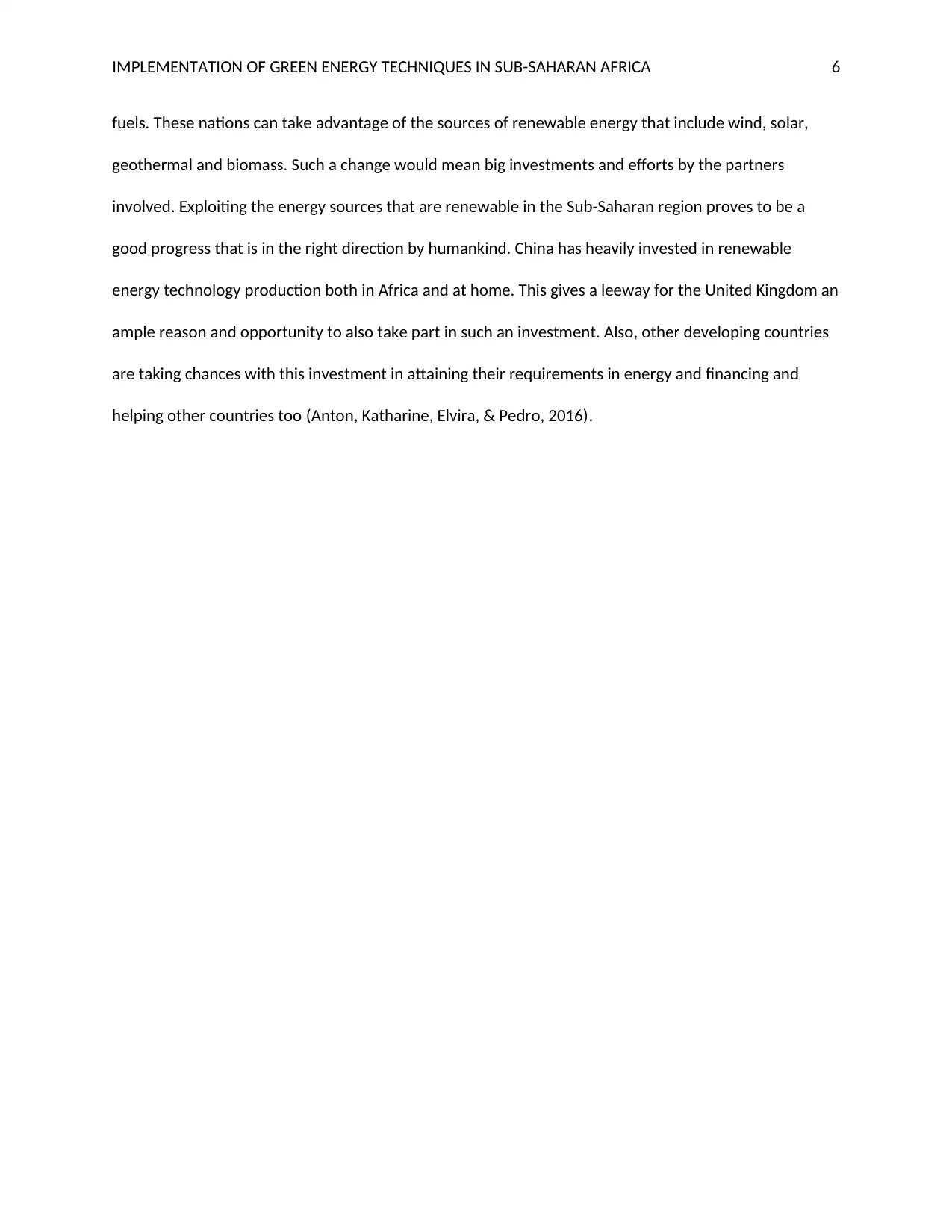
IMPLEMENTATION OF GREEN ENERGY TECHNIQUES IN SUB-SAHARAN AFRICA 6
fuels. These nations can take advantage of the sources of renewable energy that include wind, solar,
geothermal and biomass. Such a change would mean big investments and efforts by the partners
involved. Exploiting the energy sources that are renewable in the Sub-Saharan region proves to be a
good progress that is in the right direction by humankind. China has heavily invested in renewable
energy technology production both in Africa and at home. This gives a leeway for the United Kingdom an
ample reason and opportunity to also take part in such an investment. Also, other developing countries
are taking chances with this investment in attaining their requirements in energy and financing and
helping other countries too (Anton, Katharine, Elvira, & Pedro, 2016).
fuels. These nations can take advantage of the sources of renewable energy that include wind, solar,
geothermal and biomass. Such a change would mean big investments and efforts by the partners
involved. Exploiting the energy sources that are renewable in the Sub-Saharan region proves to be a
good progress that is in the right direction by humankind. China has heavily invested in renewable
energy technology production both in Africa and at home. This gives a leeway for the United Kingdom an
ample reason and opportunity to also take part in such an investment. Also, other developing countries
are taking chances with this investment in attaining their requirements in energy and financing and
helping other countries too (Anton, Katharine, Elvira, & Pedro, 2016).
⊘ This is a preview!⊘
Do you want full access?
Subscribe today to unlock all pages.

Trusted by 1+ million students worldwide
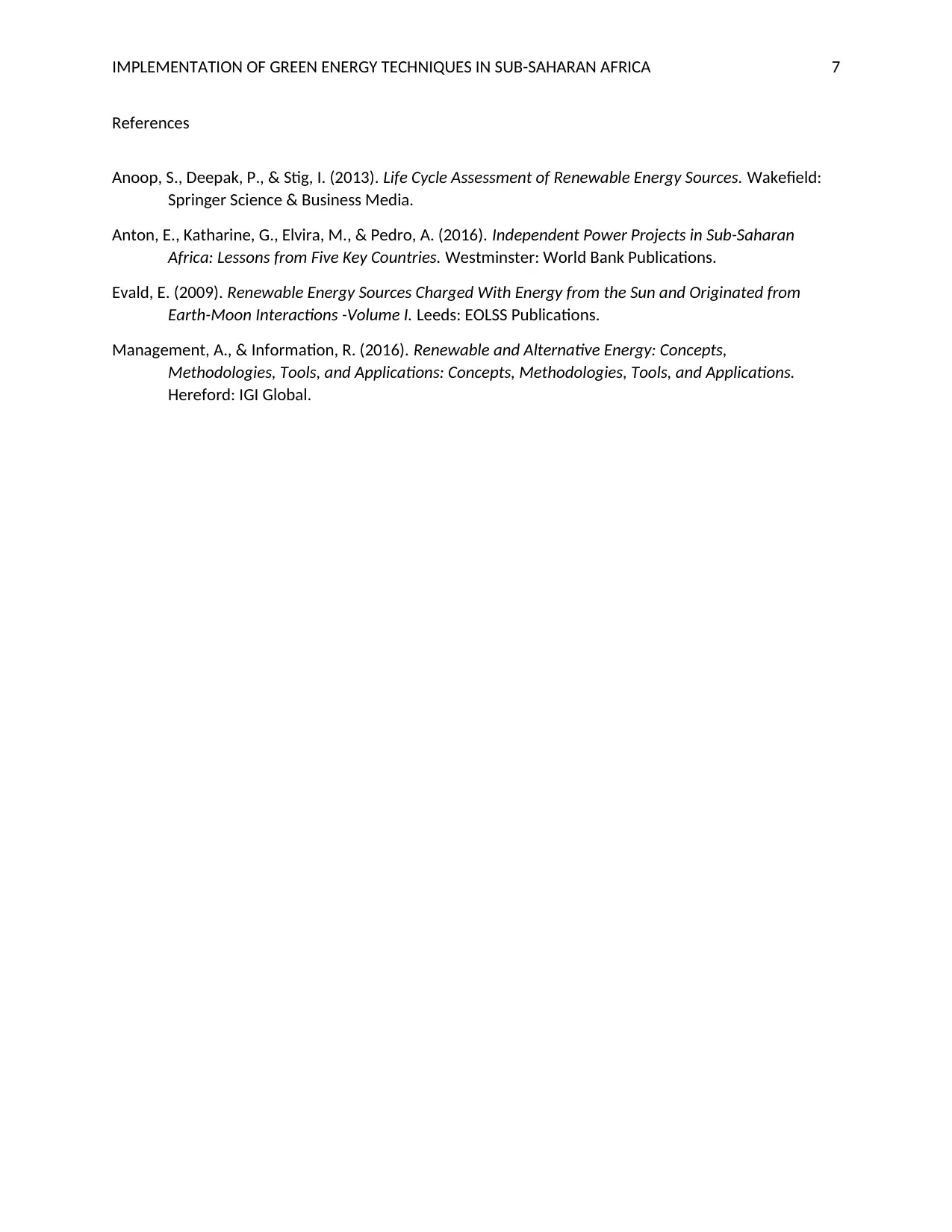
IMPLEMENTATION OF GREEN ENERGY TECHNIQUES IN SUB-SAHARAN AFRICA 7
References
Anoop, S., Deepak, P., & Stig, I. (2013). Life Cycle Assessment of Renewable Energy Sources. Wakefield:
Springer Science & Business Media.
Anton, E., Katharine, G., Elvira, M., & Pedro, A. (2016). Independent Power Projects in Sub-Saharan
Africa: Lessons from Five Key Countries. Westminster: World Bank Publications.
Evald, E. (2009). Renewable Energy Sources Charged With Energy from the Sun and Originated from
Earth-Moon Interactions -Volume I. Leeds: EOLSS Publications.
Management, A., & Information, R. (2016). Renewable and Alternative Energy: Concepts,
Methodologies, Tools, and Applications: Concepts, Methodologies, Tools, and Applications.
Hereford: IGI Global.
References
Anoop, S., Deepak, P., & Stig, I. (2013). Life Cycle Assessment of Renewable Energy Sources. Wakefield:
Springer Science & Business Media.
Anton, E., Katharine, G., Elvira, M., & Pedro, A. (2016). Independent Power Projects in Sub-Saharan
Africa: Lessons from Five Key Countries. Westminster: World Bank Publications.
Evald, E. (2009). Renewable Energy Sources Charged With Energy from the Sun and Originated from
Earth-Moon Interactions -Volume I. Leeds: EOLSS Publications.
Management, A., & Information, R. (2016). Renewable and Alternative Energy: Concepts,
Methodologies, Tools, and Applications: Concepts, Methodologies, Tools, and Applications.
Hereford: IGI Global.
1 out of 7
Related Documents
Your All-in-One AI-Powered Toolkit for Academic Success.
+13062052269
info@desklib.com
Available 24*7 on WhatsApp / Email
![[object Object]](/_next/static/media/star-bottom.7253800d.svg)
Unlock your academic potential
Copyright © 2020–2025 A2Z Services. All Rights Reserved. Developed and managed by ZUCOL.





